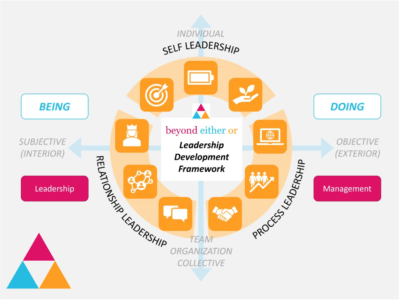Integral theory
Ken Wilber’s Integral metatheory claims that to fully observe and understand the context of any given situation, we should look through five different lenses: four quadrants, lines of intelligence, stages of development, states, and types.
As Integral Master Coaches trained by Integral Coaching Canada (ICC), we use each of these lenses to identify the specific acupressure points of highest leverage for your goals and situation. We each have more than ten years of experience applying the ICC methodology, in coaching and other contexts.
Leadership Development Framework
While we look through all five lenses of Integral Theory, we do not expect you to take the time to learn them. We may refer instead to the Leadership Development Framework which is a simpler map that we have designed for people in organisations working on some shared objectives. The four quadrants of Integral are mapped into three domains of leadership: Self Leadership, Relationship Leadership and Process Leadership. Within each domain we have identified three capabilities, equating to intelligences in the Integral model, that we have found to be particularly helpful for clients.

Are you equally skilled in these three domains of leadership? Do you believe one is more or less important than the others? Do you tend to neglect any of them?
Integrating polarities
Another framework central to our way of working is that of integrating polarities – moving from “either or” to “both and” thinking. For us, this is often about recognising and affirming the strengths are already here and important to be included in the future, while also recognising the contexts where these very strengths may hold you back and may need to be transcended. The move of include-and-transcend results in greater awareness and the availability of a wider range of options in any situation. If we attempt to transcend to some new way without including, there will be massive resistance to change.
There are some polarities that are common to many organisations. We can also help you identify those that are uniquely yours at this point in your journey.
Agile, Lean & Scrum
The practices of agile, lean and scrum are aligned with our understanding of how to maximise impact, how to learn and how to develop capabilities. Successful implementation depends on attending to Self and Relationship Leadership as well as Process Leadership. As such these practices also hold the promise of more empowerment and more rewarding, more human, experiences at work.
The Agile Manifesto of 2001 is an expression of the kind of “both and” (i.e. beyond “either or”) thinking that we like.
We are uncovering better ways of developing software by doing it and helping others do it. Through this work we have come to value:
– Individuals and interactions over processes and tools,
– Working software over comprehensive documentation,
– Customer collaboration over contract negotiation,
– Responding to change over following a plan.
That is, while there is value in the items on the right, we value the items on the left more.
Our framework of beliefs shaping behaviour and behaviour shaping impact aligns with the Lean Start-up Build-Measure-Learn process.

Other influences and practices
Our work is also informed by:
Circling
Robert Kegan
Barrett Values Model
Otto Scharmer’s Theory U
Deep Democracy
Voice Dialogue
Leadership Agility

